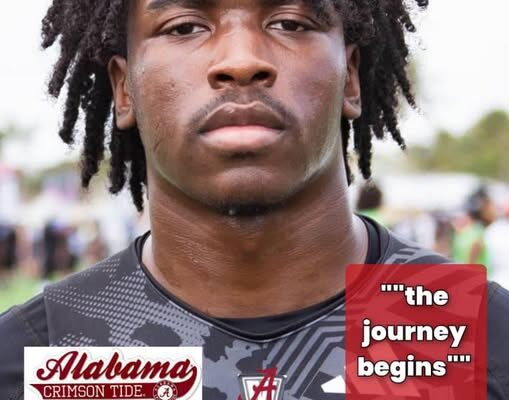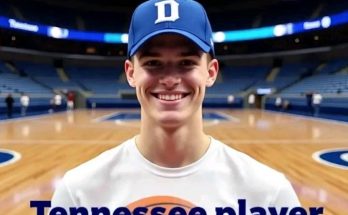The afternoon sun bore down on Tuscaloosa as the crimson tide of excitement surged through Bryant-Denny Stadium. When Jireh Edwards stepped onto Alabama soil earlier in June, few outside the program realized that this moment would mark the culmination of years of anticipation and hard-fought decision-making. What started as a mid-spring visit evolved into a commitment that rippled across the college football landscape: the elite safety prospect from Maryland had donned crimson and pledged his future to Coach Kalen DeBoer and the University of Alabama.
Despite missing the initial cut back in January, Alabama’s pursuit of this 6-foot-1, 200-pound defensive back was steady and purposeful. From the first phone call to late-night text exchanges, the Tide’s staff kept lines open, ensuring Edwards never felt a lack of attention or interest. It wasn’t just about drawing a line between recruiting and development—it was a persistent appeal rooted in the storied history of a program that prides itself on forging NFL talent. “I like the history that Alabama has and the players because the players that go to Alabama go to the league,” Edwards told On3 late last year, succinctly summing up the Tide’s magnetic pull.
For Edwards, the journey toward his commitment was carefully plotted. A prodigious talent from St. Frances Academy in Upper Marlboro, Maryland, he boasted off-the-charts athleticism combined with a high football IQ—traits that placed him among the nation’s elite: a five-star recruit, the No. 2 safety nationally in the 2026 class, a top-20 overall prospect ([on3.com][2]). Offers from nearly every blue-blood program followed: Oregon, Georgia, Auburn, Texas A\&M, Florida, Maryland, Rutgers, Penn State, Arkansas, Ohio State, Miami, USC, you name it .
Grasping the gravity of his decision, Edwards didn’t rush it. He methodically whittled down his options, aligning official visits and unofficial trips to get a true feel for each program’s culture, coaching staff, facilities, and vision for his future. His spring visit to Tuscaloosa synced perfectly with Alabama’s practice schedule—he trained alongside the current Crimson Tide, immersed himself in the campus atmosphere, and dissected the defensive framework under co-coordinators Colin Hitschler and Maurice Linguist.
In early April, Edwards visited Minnesota for Auburn. On that trip, the Tigers extended their overtures, reinforcing the pipeline from Maryland to Auburn through teammates from his high school. “They do a really hard job of making me–I can never settle on a school because the next day, Auburn will come text me and tell me some good stuff” he said, hinting at how close the Tigers had pushed. A month later, he spent mid-June weekends at Texas A\&M and Florida, both programs ramping up their efforts. Though the Aggies were early favorites for a time—Edwards said, “Texas A\&M is my leader right now” in early spring—the Tide’s proximity, prestige, and promise began to stand out.
Yet recruiting this caliber of talent is never just about stats, rankings, or on-field fit. For Edwards, personal legacy and family uplift held equal weight. As he told Sportskeeda on May 31, his eventual college decision would hinge not only on his growth on the field but who could “set me up after ball,” and valuable relationships. “I want to be around great people and be set for life after I leave. I want to create generational wealth for my family”. That financial and relational calculus made NIL a critical element in his decision matrix, as he’d explained months earlier: “Coming from a family that doesn’t have a lot… NIL plays a big factor. My goal in life is to retire the fam, so if I can do that in college, I will”.
Against that backdrop, Alabama’s NIL framework and ongoing coaching stability proved persuasive. With DeBoer entering just his second year, the program promised continuity. The coaching staff—Martin Linguist backing the DB room, safeties coach Jason Jones stepping in fresh, cornerbacks working in harmony—presented a cohesive developmental slate, a clear path from collegiate excellence to professional readiness.
Behind the scenes, grassroots ties strengthened too. ESPN, Rivals, and On3 analysts underscored Edwards’ versatility—his ability to fit as both strong and free safety, patrol deep zones, or even mix in the box. Andrew Ivins of 247Sports compared him to Georgia’s Lewis Cine: “an all-around defensive playmaker that can make an impact on Saturdays and then possibly Sundays” ([si.com][4]). That position flexibility mirrored Alabama’s defensive philosophy under defensive coordinator Kane Wommack and co-coordinator Linguist: athletic, aggressive, adaptable, and designed for high-impact playmaking.
By early June, Edwards was back in Tuscaloosa for an official visit scheduled for June 6 to 9. Reports from that visit describe a program firing on all cylinders—the energy of the players, the campus aura, the combination of elite on-field production and off-field opportunity. Despite the Tide ranking mid-pack nationally in the class of 2026 at that point, their potential to outperform projections stirred optimism. Meanwhile, other finalists—Georgia, Oregon, Auburn, Texas A\&M, Florida—all had appealing qualities, but none presented the complete package: legacy, development, NIL, draft pipeline, and coaching alignment. And when push came to shove, Alabama delivered.
On July 5, the wait ended. Per Edwards’ plan, he made his announcement. When his name echoed through Bryant-Denny’s ceremony tent, the fruition of years of work and months of deliberation crystallized: Jireh Edwards, elite safety of St. Frances Academy, pledged to the Crimson Tide. For Alabama, landing Edwards marked another key victory—continuation of a streak where blue-chip defensive backs head to the pros in droves, cementing Bama’s dominance in cultivating top-level secondary talent.
The ripples were immediate. Analysts noted how Edwards bolstered a secondary unit already strong with transfers and returning standouts, and how his presence would help draw other Maryland-area recruits. Tweetstorms spiked. Fans embraced him, excited for his combination of physicality, football IQ, and next-level potential. Former NFL alums and current pros took notice: here was a safety who could be a game-changer at the next level, and one who would enter the program deeply motivated by legacy and family impact.
For Edwards himself, the choice wasn’t just about entering a winning program—it was about making history. He wrestled with the weight of carrying family expectations, lifting generational burdens, and thriving in one of the greatest college football programs ever. There was humility in his outlook, tempered by confidence. In ripping the wrap from that Tide helmet, Edwards beamed—not just as a recruit, but as a torchbearer in a lineage of elite Alabama safeties.
When fall practices begin and jerseys are handed out, all eyes will be on No. \[To Be Revealed] as he patrols the secondary. Will he employ his trademark physical tackling? Roam sideline-to-sideline? Deliver turnovers and game-changing reads? Scouts will watch, teammates will rally, and opponents will shake their heads. And in the NFL scouting rooms next spring, conversations about the next safety off the board will inevitably include the name Jireh Edwards.
But for now, as Alabama fans reflect on the Class of 2026, this moment—the day Edwards decided his future was to be shaped in Tuscaloosa—stands apart as a milestone. It’s not just another commitment. It’s another chapter in a program’s rich history and in a family’s long arc. It’s the new dawn of a safety ready to carry crimson forward. And as the echoes of that announcement fade into summer recruiting buzz, the true legacy is only just beginning.



